
Wine Culture and Information since 2002 - Volume 22
 Wine Culture and Information since 2002 - Volume 22 |
|
Comparing Taurasi and Aglianico del VultureAglianico is one of the great grapes of South Italy, among the most important ones of the country. Vulture and Taurasi are the best expressions of this variety, mother of great and noble wines |
|
Aglianico is one of the great enological glories of South Italy. Great red berried grape capable of making great wines, Aglianico is also one of the most famous and important grapes of Italy. This great grape is common in all peninsular regions of Italy - and marginally in some regions of Central Itay and in the islands - however it is in Campania and in Basilicata Aglianico offers its best expression and notoriety. Taurasi in Campania and Vulture in Basilicata are the main areas in which the best Aglianico wines are being produced, known everywhere as an example of enological excellence. The two areas are just 60 kilometers apart, nevertheless their wines express truly different characters. History tells this grape was introduced in Italy by Greeks in the VII century BC, for this reason it was known in ancient times as Ellenico, then changed in the XV century in Aglianico - during the dominion of Aragonese - by adapting the pronounce to the Spanish language.
|
Taurasi is not only a great expression of Aglianico grape in Campania, it is also - undoubtedly - the most famous and representative red wine of the region. Taurasi, a town in province of AVellino, has certainly been the first viticultural area to give notoriety to Aglianico in Italy and in the world; the wines of this area are in fact classified as Denominazione d'Origine Controllata e Garantita since 1993 (Denomination of Controlled and Guaranteed Origin, DOCG). Taurasi has quickly conquered notoriety and became - in a short time - one of the most famous wines and viticultural areas of South Italy. a result obtained, with no doubt, with real facts and with the quality of its wines. Aglianico has certainly played a fundamental role for the success of Taurasi, however - it should be remembered - a wine it is not only the fruit of the grape used for its production, it is the result of a territory and of its characteristics, grape included. Or, better to say, it is the expression of Aglianico in that territory. According to the production disciplinary, Taurasi is produced with Aglianico grape, for at least 85% and providing for the possible remaining part of non aromatic grapes permitted for the cultivation in the territory. The use of other varieties is however rare for Taurasi, as most of producers prefer making use of Aglianico only, a variety having a strong bond with this territory. Still according to the production disciplinary, Taurasi must age for at least three years before being commercialized, of which, at least one in wood cask. As for the riserva style, it is required a minimum aging period of four years, of which at least 18 months in wood. Thanks to the quality of Aglianico, Taurasi is a wine capable of aging for many years in bottle, getting with time a rounder and more elegant character.
|
||||||||
|
The area of Vulture is found in Basilicata and takes its name from the homonymous volcano, inactive today. The composition of the soil is therefore of lavatic nature, a characteristic giving unique qualities to wines, different from - of course - any other place. Aglianico del Vulture is characterized by power and structure. The versatility of this grape has given origin - in this land - to many enological interpretations, from whites to sparkling wines, as well as rich and excellent red wines. Aglianico del Vulture has been recently ranked - the last August 2010 and for the superiore style only - as a wines of Denominazione d'Origine Controllata e Garantita (Denomination of Controlled and Guaranteed Origin, DOCG), the highest level of the quality system in force in Italy. The great red of Basilicata, according to the relative disciplinary, is produced with 100% Aglianico grape and it can be commercialized after at least three years of aging, of which at least 12 months in cask. The riserva style requires a period of aging of five years, of which, at least 24 months in cask. In the Vulture area, Aglianico is cultivated in vineyards which can also reach 800 meters of altitude, however it is believed the best cultural and enological conditions are obtained in altitudes from 200 and 600 meters. Wines of Vulture have been mentioned many times in the past, one of the first ones was the Latin poet Horace - who was born in Venosa, still today an important land of Aglianico del Vulture - and, later, both Sante Lancerio and Andrea Bacci will write high praises for this wine. Despite Aglianico del Vulture has recently obtained the DOCG status, its fame and its value are well known to wine lovers since many years, recognizing to the wines of this area very high quality and value. Of robust body and complexity, Aglianico del Vulture was successful in conquering the favor of consumers, proving, glass after glass, its undeniable excellence.
|
||||
|
Our comparative tasting will examine the two main territories in which Aglianico grape is capable of expressing wines of remarkable personality. The first wine of the tasting is Mastroberardino's Taurasi Riserva Centotrenta, produced with 100% Aglianico and aged in cask and in barrique for 18 months and then aged for 18 months in bottle. The second wine we will examine is Cantine del Notaio's Aglianico del Vulture Il Sigillo, aged for 24 months in barrique. As Aglianico is a grape rich in polyphenols, in both cases have been chosen wines longly aged in wood containers in order to compare wines with ripe tannins and complex organoleptic profiles. In both cases, we will choose the vintages currently commercialized by respective producers. The wines will be tasted at the temperature of 18°C (65°F) and served in two ISO tasting glasses.
|
|
Aglianico is a grape rich in polyphenolic substance, characteristic which - of course - strongly affects the appearance in red wines. The intensity and concentration of colors also depends on other cultural and environmental factors. The soil of Taurasi, compared to the one of Vulture, is generally riches in clay - however both being of lavatic nature - and therefore its wines are characterized by more intense and deep colors, whereas the ones of Vulture are characterized by a higher transparency. The soil factor is of course one of the many determining the color of a wine, among them the yield in vineyard: the lower the yield, the higher the concentration of colors. Both Taurasi and Aglianico del Vulture are commercialized after a long period of aging, therefore it is quite rare to see in these wines purple red hues. The main colors in these wines are therefore ruby red and garnet red. The first wine of which we will examine appearance is Mastroberardino's Taurasi Riserva Centotrenta. By tilting the glass over a white surface - for example, a towel or a sheet of paper - let's observe the wine at the base of the glass, where the wine gets the maximum thickness. We will observe a brilliant and intense ruby red color, with a moderate transparency. Let's now observe the wine towards the opening of the glass, in the point where the thickness of the liquid is at the minimum. Here it can be observed a garnet red color, sign of aging and of time. Let's now pass to the evaluation of Cantine del Notaio's Aglianico del Vulture Il Sigillo. Observed at the base of the glass, in this wine can be appreciated an intense and brilliant ruby red color, also in this case with a moderate transparency, however lower than the previous wine. Nuances of this Aglianico - observed at the edge of the glass - are characterized by an intense ruby red color.
|
|
Wines produced with Aglianico offer to the nose of the taster a very interesting aromatic profile. If we add the excellent longevity in bottle - a factor further enriching Aglianico of tertiary and complex aromas - the olfactory evaluation of these wines offers the taster an extremely interesting exercise. Both Taurasi and Aglianico del Vulture offer to the nose a profile mainly made from intense sensations of fruits and flowers, of which the most frequent ones are black cherry, blackberry, plum and violet. Time and aging in cask give Aglianico complex tertiary aromas. Moreover, thanks to its characteristics, Aglianico makes wines of remarkable longevity in bottle, developing aromas of high complexity. Time and aging give Aglianico complex aromas of vanilla, cocoa, tobacco, mace, licorice, leather, chocolate and cinnamon, just to mention the most frequent ones. In these wines can also be perceived fresh and balsamic aromas of menthol. Mastroberardino's Taurasi Riserva Centotrenta will be the first wine of which we will evaluate the olfactory profile. By keeping the glass in vertical position and without swirling, let's proceed with the evaluation of opening aromas. From the glass will be appreciated aromas of plum, blackberry, black cherry and violet, typical and identifying qualities of Aglianico grape. Let's now proceed with the swirling of the glass in order to favor the oxygenation of the wine, then let's do the second smell in order to complete the aromatic sequence. It will be now perceived aromas of blueberry as well as more complex aromas of vanilla, cocoa, tobacco, mace, leather, licorice and a balsamic touch of menthol. Let's now pass to the evaluation of Cantine del Notaio's Aglianico del Vulture Il Sigillo. The opening of this wine is characterized - like the previous one - by aromas of plum, blackberry, black cherry and violet. After having swirled the glass, the aromatic profile is completed by blueberry, vanilla, chocolate, cinnamon, mace, tobacco, pink pepper and a pleasing touch of menthol.
|
|
Aglianico is not a grape going unnoticed when its wines are being poured in a glass. This extraordinary grape, not so easy to cultivate and to vinify in cellar, has a pretty rich content in polyphenols as well as a pretty high acidity. With such characteristics, the balance in wines is obtained both by the contribution of alcohol - in these wines being frequently higher than 14% - as well as a proper aging in cask, in order to “smooth” the strong astringency and to mitigate the crispness given by acidity. Both Taurasi and Aglianico del Vulture are wines of remarkable structure, with a pretty high alcohol by volume and with a strong astringency, in which acidity, although smoothed by the aging in wood, however plays a determinant role in balance. Correspondence to the nose is generally very good - in the mouth can be perceived clean flavors of black cherry, blackberry and plum - and persistence is very good, frequently with a long duration. Let's examine the first wine of our comparative tasting: Mastroberardino's Taurasi Riserva Centotrenta. The attack of this wine - that is the sensations perceived at the first sip - is characterized by the astringent personality of Aglianico as well as a pretty robust structure. Despite the wine has a certain roundness given by the aging in wood, it can however be perceived a good acidity. The balance of the wine is also obtained by alcohol, which is well perceived with its “warm” effect. Let's now pass to Cantine del Notaio's Aglianico del Vulture Il Sigillo. Also in this case the attack is characterized by a remarkable structure, however roundness given by the aging in wood and by alcohol give a good balance to the wine. In both wines can be perceived an excellent correspondence with the flavors of black cherry, blackberry and plum, as well as a long taste-olfactory persistence. Finally, it should be compared the organoleptic sensations in both wines according to the different methods of aging.
|
Wines of the Month |
|
|
|
Score legend Prices are to be considered as indicative. Prices may vary according to the country or the shop where wines are bought |

|
|
Collina d'Oro 2009 |
|
| Roccafiore (Umbria, Italy) | |
| Grapes: Moscato Giallo | |
| Price: € 15.00 - 375ml | Score: |
| Collina d'Oro shows an intense golden yellow color and nuances of golden yellow, transparent. The nose reveals intense, clean, pleasing and refined aromas which start with hints of raisin, dried fig and almond followed by aromas of peach jam, dried apricot, candied fruits, vanilla, citrus fruit peel, honey and lavender. The mouth has good correspondence to the nose, a sweet and round attack, however balanced by alcohol, good body, intense flavors, pleasing crispness. The finish is persistent with flavors of raisin, dried apricot and dried fig. Collina d'Oro ages for 12 months in barrique. | |
| Food Match: Confectionery, Dried fruit tarts, Piquant cheese | |
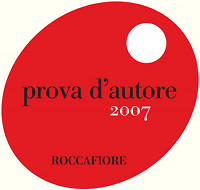
|
|
Prova d'Autore 2007 |
|
| Roccafiore (Umbria, Italy) | |
| Grapes: Sangiovese, Sagrantino, Montepulciano | |
| Price: € 22.00 | Score: |
| Prova d'Autore shows an intense ruby red color and nuances of garnet red, little transparency. The nose reveals intense, clean, pleasing, refined and elegant aromas which start with hints of plum, black cherry and blackberry followed by aromas of dried violet, blueberry, vanilla, chocolate, leather, tobacco and menthol. The mouth has good correspondence to the nose, a tannic attack and however balanced by alcohol, good body, intense flavors, pleasing roundness. The finish is persistent with flavors of plum, black cherry and blackberry. Prova d'Autore ages for 2 years in barrique followed by 12 months of aging in bottle. | |
| Food Match: Roasted meat, Stewed and braised meat, Hard cheese | |
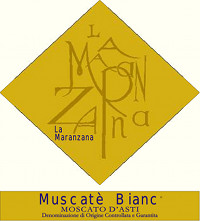
|
|
Moscato d'Asti Muscatè Bianc 2009 |
|
| Cantina Maranzana (Piedmont, Italy) | |
| Grapes: Muscat Blanc | |
| Price: € 3.70 | Score: |
| Moscato d'Asti Muscatè Bianc shows a brilliant greenish yellow color and nuances of greenish yellow, very transparent. The nose denotes intense, clean and pleasing aromas that start with hints of grape, peach and pear followed by aromas of white rose, apple, lychee and sage. The mouth has good correspondence to the nose, a sweet and effervescent attack, however balanced by alcohol, light body, intense flavors, pleasing crispness. The finish is persistent with flavors of grape, peach and lychee. Moscato d'Asti Muscatè Bianc ferments in closed tank. | |
| Food Match: Fruit desserts, Semifreddo | |
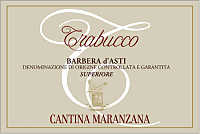
|
|
Barbera d'Asti Superiore Trabucco 2007 |
|
| Cantina Maranzana (Piedmont, Italy) | |
| Grapes: Barbera | |
| Price: € 6.00 | Score: |
| Barbera d'Asti Superiore Trabucco shows an intense ruby red color and nuances of garnet red, moderate transparency. The nose denotes intense, clean, pleasing and refined aromas that start with hints of cherry, plum and violet followed by aromas of blackberry, blueberry, vanilla, tobacco, mace and pink pepper. The mouth has good correspondence to the nose, a slightly tannic attack and pleasing crispness, however balanced by alcohol, good body, intense flavors, agreeable. The finish is persistent with flavors of cherry, plum and blueberry. Barbera d'Asti Superiore Trabucco ages for 12 months in cask followed by 6 months of aging in bottle. | |
| Food Match: Roasted meat, Broiled meat and barbecue, Stewed and braised meat with mushrooms | |
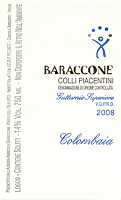
|
|
Colli Piacentini Gutturnio Superiore Colombaia 2008 |
|
| Baraccone (Emilia Romagna, Italy) | |
| Grapes: Barbera (70%), Croatina (30%) | |
| Price: € 9.80 | Score: |
| Colli Piacentini Gutturnio Superiore Colombaia shows an intense ruby red color and nuances of ruby red, little transparency. The nose denotes intense, clean, pleasing and refined aromas which start with hints of black cherry, plum and violet followed by aromas of raspberry, blackberry, blueberry, carob and vanilla. The mouth has good correspondence to the nose, a slightly tannic attack and however balanced by alcohol, good body, intense flavors, pleasing crispness. The finish is persistent with flavors of black cherry, plum and blueberry. Colli Piacentini Gutturnio Superiore Colombaia ages for 3 months in barrique followed by at least 8 months of aging in bottle. | |
| Food Match: Sauteed meat, Broiled meat and barbecue, Hard cheese | |
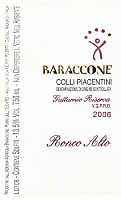
|
|
Colli Piacentini Gutturnio Riserva Ronco Alto 2006 |
|
| Baraccone (Emilia Romagna, Italy) | |
| Grapes: Barbera (70%), Croatina (30%) | |
| Price: € 14.00 | Score: |
| Colli Piacentini Gutturnio Riserva Ronco Alto shows an intense ruby red color and nuances of ruby red, little transparency. The nose denotes intense, clean, pleasing and refined aromas which start with hints of cherry, plum and violet followed by aromas of blueberry, raspberry, blackberry, vanilla, tobacco and cocoa. The mouth has good correspondence to the nose, a slightly tannic attack and however balanced by alcohol, good body, intense flavors, pleasing crispness. The finish is persistent with flavors of cherry, plum and blackberry. Colli Piacentini Gutturnio Riserva Ronco Alto ages for 12 months in barrique followed by at least one year of aging in bottle. | |
| Food Match: Roasted meat, Stewed and braised meat with mushrooms, Hard cheese | |
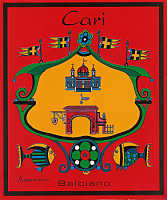
|
|
Collina Torinese Cari 2009 |
|
| Balbiano (Piedmont, Italy) | |
| Grapes: Pelaverga (85%), Other Grapes (15%) | |
| Price: € 6.80 | Score: |
| Collina Torinese Cari shows a deep cherry pink color and nuances of cherry pink, moderate transparency. The nose denotes intense, clean and pleasing aromas that start with hints of raspberry, strawberry and cherry followed by aromas of geranium, cyclamen and plum. The mouth has good correspondence to the nose, a sweet and effervescent attack, however balanced by alcohol, slight body, intense flavors, pleasing crispness. The finish is persistent with flavors of raspberry, cherry and strawberry. | |
| Food Match: Fruit and cream desserts, Semifreddo | |
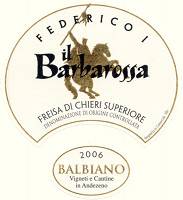
|
|
Freisa di Chieri Secco Fermo Superiore Riserva Barbarossa 2006 |
|
| Balbiano (Piedmont, Italy) | |
| Grapes: Freisa | |
| Price: € 8.80 | Score: |
| Freisa di Chieri Secco Fermo Superiore Riserva Barbarossa shows an intense ruby red color and nuances of ruby red, little transparency. The nose reveals intense, clean, pleasing and refined aromas which start with hints of cherry, plum and dried violet followed by aromas of blueberry, carob, vanilla, mace and cinnamon. The mouth has good correspondence to the nose, a slightly tannic attack and however balanced by alcohol, good body, intense flavors, agreeable. The finish is persistent with flavors of cherry, plum and blueberry. Freisa di Chieri Secco Fermo Superiore Riserva Barbarossa ages for 6 months in cask followed by more than 8 months of aging in bottle. | |
| Food Match: Roasted meat, Broiled meat and barbecue, Stewed and braised meat, Hard cheese | |
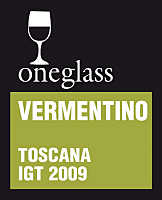
|
|
Vermentino 2009 |
|
| Oneglass (Veneto, Italy) | |
| Grapes: Vermentino (85%), Chardonnay (15%) | |
| Price: € 1.60 - 100ml | Score: |
| This Vermentino shows a pale golden yellow color and nuances of greenish yellow, very transparent. The nose denotes intense, clean and pleasing aromas that start with hints of pear, peach and hawthorn followed by aromas of almond, pineapple and plum. The mouth has good correspondence to the nose, a crisp attack and however balanced by alcohol, good body, intense flavors. The finish is pretty persistent with flavors of pear, peach and pineapple. | |
| Food Match: Pasta with meat and fish, White sauteed meat, Vegetable soups, Sauteed fish | |
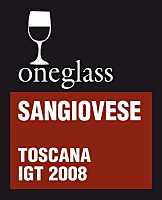
|
|
Sangiovese 2008 |
|
| Oneglass (Veneto, Italy) | |
| Grapes: Sangiovese (85%), Syrah (15%) | |
| Price: € 1.60 - 100ml | Score: |
| This Sangiovese shows an intense ruby red color and nuances of garnet red, moderate transparency. The nose denotes intense, clean and pleasing aromas that start with hints of black cherry, plum and violet followed by aromas of blueberry, black currant and carob. The mouth has good correspondence to the nose, a slightly tannic attack and however balanced by alcohol, good body, intense, flavors. The finish is pretty persistent with flavors of black cherry and plum. | |
| Food Match: Sauteed meat, Pasta with meat, Roasted white meat | |
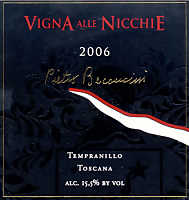
|
|
Vigna alle Nicchie 2006 |
|
| Pietro Beconcini (Tuscany, Italy) | |
| Grapes: Tempranillo | |
| Price: € 35.00 | Score: |
| Vigna alle Nicchie shows a deep ruby red color and nuances of garnet red, little transparency. The nose denotes intense, clean, pleasing, refined and elegant aromas which start with hints of black cherry, plum and blackberry followed by aromas of dried violet, vanilla, blueberry, chocolate, leather, licorice, pink pepper, tobacco and menthol. The mouth has good correspondence to the nose, a tannic attack and however balanced by alcohol, full body, intense flavors, pleasing roundness. The finish is persistent with flavors of plum, black cherry and blackberry. Vigna alle Nicchie ages for 20 months in barrique followed by 24 months of aging in bottle. | |
| Food Match: Game, Roasted meat, Stewed and braised meat, Hard cheese | |

|
|
Vin Santo del Chianti Caratello 2001 |
|
| Pietro Beconcini (Tuscany, Italy) | |
| Grapes: Malvasia Bianca, Malvasia Nera, Trebbiano Toscano, San Colombano | |
| Price: € 25.00 - 50cl | Score: |
| Vin Santo del Chianti Caratello shows an intense amber yellow color and nuances of amber yellow, transparent. The nose reveals intense, clean, pleasing, refined and elegant aromas which start with hints of dried fig, almond and caramel followed by aromas of raisin, plum jam, quince jam, walnut husk, honey, nail polish, vanilla and leather. The mouth has good correspondence to the nose, a sweet and round attack, however balanced by alcohol, full body, intense flavors, pleasing crispness. The finish is persistent with flavors of raisin, dried fig and honey. Vin Santo del Chianti Caratello ages in small barrels for 5 years followed by 12 months of aging in bottle. | |
| Food Match: Dried fruit tarts, Confectionery, Piquant cheese | |
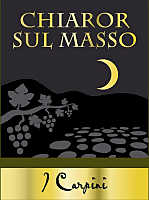
|
|
Chiaror sul Masso 2008 |
|
| Cascina I Carpini (Piedmont, Italy) | |
| Grapes: Timorasso | |
| Price: € 16.00 | Score: |
| Chiaror sul Masso shows a brilliant greenish yellow color and nuances of greenish yellow, very transparent, fine and persistent perlage. The nose denotes intense, clean, pleasing and refined aromas which start with hints of apple, plum and mineral followed by aromas of bread crust, citrus fruits, pineapple and pear. The mouth has good correspondence to the nose, an effervescent and crisp attack, however balanced by alcohol, good body, intense flavors, agreeable. The finish is persistent with flavors of pear, plum and pineapple. Chiaror sul Masso is made with the long Martinotti method and referments in tank for 30 days. | |
| Food Match: Pasta and risotto with vegetables and crustaceans, Mushroom soups, Sauteed white meat | |
|
||||||||
|
DiWineTaste Polls
|
| |||||||
Privacy Policy | |||||||


| Copyright © 2002-2024 Antonello Biancalana, DiWineTaste - All rights reserved |
| All rights reserved under international copyright conventions. No part of this publication and of this WEB site may be
reproduced or utilized in any form or by any means, electronic or mechanical, without permission in writing from DiWineTaste. |